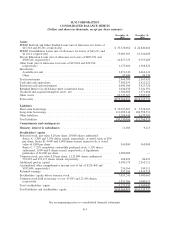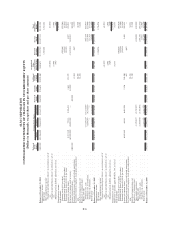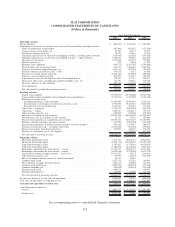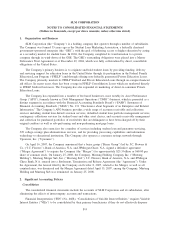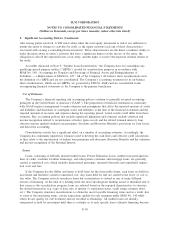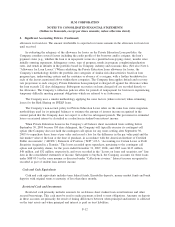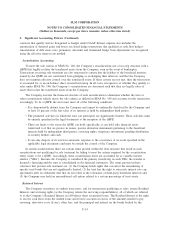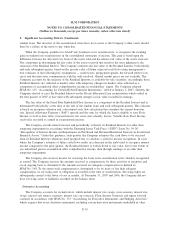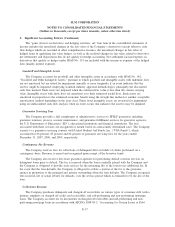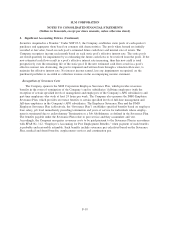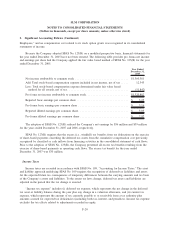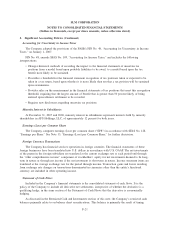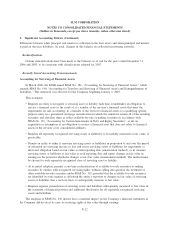Sallie Mae 2007 Annual Report Download - page 133
Download and view the complete annual report
Please find page 133 of the 2007 Sallie Mae annual report below. You can navigate through the pages in the report by either clicking on the pages listed below, or by using the keyword search tool below to find specific information within the annual report.2. Significant Accounting Policies (Continued)
allowance for loan loss. The amount attributable to expected recoveries remains in the allowance for loan loss
until received.
In evaluating the adequacy of the allowance for losses on the Private Education Loan portfolio, the
Company considers several factors including the credit profile of the borrower and/or cosigner, the loan’s
payment status (e.g., whether the loan is in repayment versus in a permitted non-paying status), months since
initially entering repayment, delinquency status, type of program, trends in program completion/graduation
rates, and trends in defaults in the portfolio based on Company, industry and economic data. (See also Note 4,
“Allowance for Loan Losses.”) When calculating the Private Education Loan allowance for losses, the
Company’s methodology divides the portfolio into categories of similar risk characteristics based on loan
program type, underwriting criteria and the existence or absence of a cosigner, with a further breakdown for
each of the factors mentioned above within these categories. The Company then applies default and recovery
rate projections to each category. Private Education Loan principal is charged off against the allowance when
the loan exceeds 212 days delinquency. Subsequent recoveries on loans charged off are recorded directly to
the allowance. The Company’s collection policies allow for periods of nonpayment for borrowers experiencing
temporary difficulty meeting payment obligations which are referred to as forbearance.
The Company uses a similar methodology applying the same factors (where relevant) when estimating
losses for the Risk Sharing on FFELP loans.
The Company’s non-accrual policy for Private Education Loans relies on the same loan status migration
methodology used for its principal balances to estimate the amount of interest income recognized in the
current period that the Company does not expect to collect in subsequent periods. The provision for estimated
losses on accrued interest is classified as a reduction in student loan interest income.
When Private Education Loans in the Company’s off-balance sheet securitized trusts settling before
September 30, 2005 become 180 days delinquent, the Company will typically exercise its contingent call
option (the Company does not hold the contingent call option for any trusts settling after September 30,
2005) to repurchase these loans at par value and record a loss for the difference in the par value paid and the
fair market value of the loan at the time of purchase, in accordance with the American Institute of Certified
Public Accountants’ (“AICPA”) Statement of Position (“SOP”) 03-3, “Accounting for Certain Loans or Debt
Securities Acquired in a Transfer.” The losses recorded upon repurchase, pertaining to the contingent call
option and speciality claims, for the years ended December 31, 2007, 2006, and 2005 were $123 million,
$48 million, and $32 million, respectively, and were recorded in the “Losses on loans and securities, net” line
item in the consolidated statements of income. Subsequent to buyback, the Company accounts for these loans
under SOP 03-3 in the same manner as discussed under “Collections revenue.” Interest income recognized is
recorded as part of student loan interest income.
Cash and Cash Equivalents
Cash and cash equivalents includes term federal funds, Eurodollar deposits, money market funds and bank
deposits with original terms to maturity of less than three months.
Restricted Cash and Investments
Restricted cash primarily includes amounts for on-balance sheet student loan securitizations and other
secured borrowings. This cash must be used to make payments related to trust obligations. Amounts on deposit
in these accounts are primarily the result of timing differences between when principal and interest is collected
on the trust assets and when principal and interest is paid on trust liabilities.
F-12
SLM CORPORATION
NOTES TO CONSOLIDATED FINANCIAL STATEMENTS
(Dollars in thousands, except per share amounts, unless otherwise stated)




